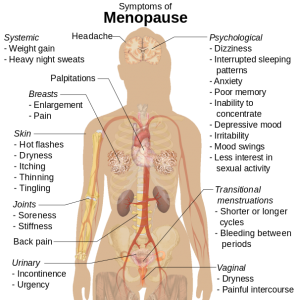What is menopause?
Menopause is the end of the female menstural period, diagnosed 12 months from one’s last. It is associated with many natural changes. In the lead up to menopause, women go through the peri- menopause phase which includes a period of hot flushes, vaginal and sexual changes, altered mood, sleep and a change in bleeding pattern. All of which have a huge impact on one’s quality of life before menopause has even started. Two important changes needing to be considered during this phase include muscle strength and bone density.

The role of oestrogen:
Menopause is associated with a natural decline in oestrogen. Loss of oestrogen causes variable symptoms at different sites in the body. This natural decline causes an increase in visceral fat, decreased bone mass density, muscle mass and strength. Strength decline occurs due to changes in both muscle function and the size of muscle cells. Oestrogen plays an important role in maintaining bone strength. When oestrogen levels drop it can result in increased bone loss. Causing osteoporosis whereby bones become fragile and fracture easily.
Muscle strength with age:
As we age, the importance of retaining strength increases. The loss of muscle strength can be detrimental to one’s physical function. Ensuring that strength is maintained allows for activities of daily living to be achieved. These include simple tasks such as standing from being seated in a chair, climbing stairs, walking speed,and the correction after a slight balance disturbance.
Women experience associated strength loss at an earlier rate than males. Women generally lose muscle strength in their 50’s and 60’s typically around the time of menopause. It can be said that women will experience a 20% loss of their strength between the ages 25-55. Some women can spend more than 30 years in a post menopause period. Not only does menopause affect bone density but it has a great impact on one’s strength. Low protein intake and decreased physical activity are some of the main contributing factors to muscle strength decline, however hormonal changes also contribute. There is said to be a correlation between the decline of oestrogen levels and muscle strength.
The positive effects of exercise:
The best type of exercise to undertake to help with strength loss and decreasing bone density is resistance training. It not only helps to maintain muscle mass but also loads our bones helping to prevent osteoporosis. Along with resistance training, diet needs to be taken into consideration. It is important to ensure protein intake is adequate, providing essential amino acids, the building blocks of our muscles.
Strength training will help to build bone density and muscle strength, increase your metabolism in turn burning more fat through the body. The best kind of strength training is with the use of resistance to load your muscles and bones. Using dumbbells, resistance therabands, and weight bearing exercises are the best way to load and elicit change in our muscle and bone structures. Aiming for strength training 2-3 times a week will help to gain some strength benefits. Strength training will not only build muscle mass and aid bone density but will also increase your metabolic rate. This will, in turn, burn fat.

Fact Sheet on Menopause: https://www.menopause.org.au/health-info/fact-sheets
References:
- Karvinen S, Juppi HK, Le G, Cabelka CA, Mader TL, Lowe DA, Laakkonen EK. Estradiol deficiency and skeletal muscle apoptosis: Possible contribution of microRNAs. Exp Gerontol. 2021 Feb 4;147:111267. doi: 10.1016/j.exger.2021.111267. Online ahead of print.PMID: 33548486
- Delamater L, Santoro N. Management of the Perimenopause. Clin Obstet Gynecol. 2018 Sep;61(3):419-432. doi: 10.1097/GRF.0000000000000389. PMID: 29952797; PMCID: PMC6082400.
~ Alex Walker
Pelvic Floor Physiotherapist

